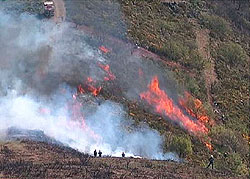Validation:
All work presented on this website has been carried using CFD. Simulations, their results, following analysis and predictions are based on unvalidated outputs of FDS5. Much effort has been put to place this study in frame with the sparse existing experimental data as well as previous CFD work. While the study has aimed for acceptable accuracy in the results, validation is a pending issue until comparison with experimental results is possible. Validation studies, which the author is unable to undertake, would confirm or disconfirm if the predictions made here using the proposed CFD model are correct. If validation turned out to be successful the model proposed in here could then be applied in the real life scenarios to asses if the fire conditions are appropriate for counter-firing.
Suggested outline for the experimental studies involves several controlled burnouts of long-stretching fire-lines. A selection of different wind and fire intensity conditions should be tested in order to establish their effect on the in-draft behaviour. Velocity measurements should be taken at a number of distances downwind form the fire. Experimental conditions should be input to the proposed computer-based model using the code available in downloads. Comparison of both, experimental and computer generated results should take into consideration the fluctuating nature of the flow, as well as the time needed for the flow to develop in the CFD model.
Study thus conducted should firmly establish:
Suggested outline for the experimental studies involves several controlled burnouts of long-stretching fire-lines. A selection of different wind and fire intensity conditions should be tested in order to establish their effect on the in-draft behaviour. Velocity measurements should be taken at a number of distances downwind form the fire. Experimental conditions should be input to the proposed computer-based model using the code available in downloads. Comparison of both, experimental and computer generated results should take into consideration the fluctuating nature of the flow, as well as the time needed for the flow to develop in the CFD model.
Study thus conducted should firmly establish:
- Influence of both wind and fire intensity on in-draft velocity;
- Minimum fire-line width appropriate for CFD modelling using 2D;
- Scale of errors by using the proposed CFD model;
- Appropriateness of the proposed CFD model in study of counter-fires.

